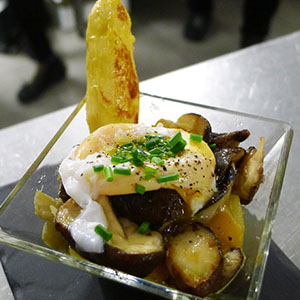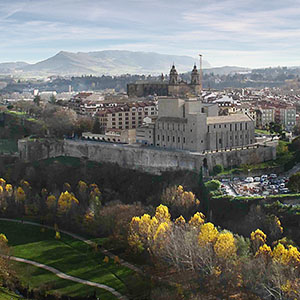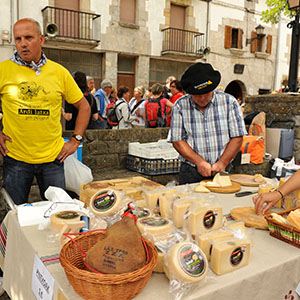It’s a little before dawn on July 7 and already thousands of spectators are jockeying for a spot behind newly-erected safety fences along Calle Santo Domingo in Pamplona, Spain for the Running of the Bulls. Those lucky enough to live on the street in apartments with balconies don’t need to appear quite that early. Well before 8 a.m., all are cheering the hundreds of runners, called ‘mozos,’ that have gathered in the Palaza de Santa Domingo to hear the church of San Cernin strike the starting hour of the traditional event.

It’s then that the first two rockets are fired into the sky, alerting the runners that the bulls have been released, each weighing 1,350 pounds. These are the bovines that will take part in the day’s bullfights. Along with them, steers are also released to act as guides for the bulls throughout the half-mile route that twists and turns along four narrow streets, ending at the Palaza de Toros. The speed of this thunderous-thumping herd reaches 15 mph. Every runner knows this is no time to dawdle, nor is it a race for the feint of heart. For this is a high-octane, adrenalin-pumping event, and, though it’s over in less than two-and-a-half minutes, you better be faster than the breath of the charging bull behind you.
When you hear two more rockets go off, signaling that all the bulls are in the ring, you can count yourself lucky. (A cautionary note: every year hundreds of runners are hurt and, since record-keeping began in 1910, 15 people have been gored to death. No one under 18 is allowed to participate, nor those whose bravery falsely stems from alcohol.)
And They’re Off
Once all the bulls are in the ring, the day’s matadors take over, guiding them into their pens in anticipation of the bull fights, called ‘corridas,’ later in the day.
Though not required, dressing in the traditional San Fermin Festival garb, consisting of a white shirt, trousers or skirt with a red scarf tied around the waist and neck, can only add to your festive mood. Not to worry if you don’t have such an outfit; just about every corner shop is well-stocked for the occasion.

The running of the bulls, known as the Encierro, has become synonymous with the Festival of San Fermín, which takes place annually from July 6 through 14. It draws local and international runners and a million revelers to this inviting town that dates back to 75 BC. That’s when the Roman general Pompey founded the town of Pompaelo on the site of the old Basque settlement of Irunea. You can see and feel the Basque influence in the town’s architecture as well as in its culture, language and food, for it’s still the largest of the Basque regions.
Though the first official festival dates to 1591, it didn’t become an international sensation until Ernest Hemingway put it on the map with his 1926 novel The Sun Also Rises. Not only did he write about the running of the bulls, but Hemingway also visited the town in the 20s and again in the ’50s. You can still stop by his favorite haunts, Bar Txoko, Café Iruna and the Hotel la Perla.
True, there’s a running of the bulls and bull fights each day of the festival, but they’re just one part of the more than 400 events to enjoy, for this is a celebration of culture, history and food like no other — with entertainment, if not quite 24/7, then very close to it.
A few events not to miss include the first day’s opening ceremony of Chupinazo on July 6. Well before noon, crowds begin gathering in front of the town hall in the Plaza Ayuntamiento where, at the stroke of 12, the mayor steps onto the hall’s balcony to greet all, crying out “Pamploneses, Pamplonesas, Viva San Fermin! Viva Gora!” The crowd responds in kind, shouting “Viva!” and “Gora!” After the burst of cheers, the launching of a rocket begins a day devoted to singing and dancing in the streets, with plenty of food, wine and sangria to add to the party atmosphere.
Another crowd-pleaser, especially with children, is the parade of Gigantes, held every morning. Huge paper mâché figures dressed in colorful, and often elaborate, costumes twirl and dance in the streets in a procession to honor San Fermin.

Then there’s the Fire Bull. Every evening during the festival, a man encased in a steel drum and covered in exploding firecrackers runs through the streets to the squeals of delight from both young and old spectators. Religious ceremonies, as well as demonstrations in traditional crafts, also figure high in festival activities.
And, oh yes, there really is a Running of the Nudes. It’s held the day before the festival’s official opening. Animal rights activists, dressed in white underwear and red scarves, run with plastic bullhorns in protest of the bullfights.
Nightly fireworks light up the sky over the old Citadel come 11 p.m. Closing the eight-day celebration on July 14 is a candlelight procession to the old church in the Plaza de Castillo, where locals lament the end of the festival, singing the sad song, “Pobre de Mí.” (“Poor me, the Fiesta de San Fermín has ended.”)
Must-See Sights
All excitement of the festival aside, Pamplona is a wondrous mix of old and new. The capitol of Navarra is set between the Arga River and the foothills of the Pyrenees. The city offers a rich glimpse into the region’s long history as a fortified border town and, today, stands as a financial, commercial, academic and cultural center.

Just a few of the must-see sights to take in while you’re in Pamplona include the 16th-century citadel Ciudalela, where you can climb to the top of one of the remaining bastions for a bird’s-eye view of the area; Iglesia San Saturnino, also known as Iglesia San Cernin, the Romanesque church dating to the 13th century; and the Museo de Navarra, which features Roman mosaics, Gothic and Baroque murals and an ivory casket inspired by Islamic motifs.
Tony stores, food emporiums and cheese shops, and world-class hotels, restaurants and cafés on both sides of the river beckon visitors at every turn.

But for me, wherever I go, it all comes down to the food and wines of the region. And Pamplona and Navarra do not disappoint. Because of Navarra’s diverse climate, which spans the forested mountains and fertile valleys in the north to a Mediterranean clime in the south, it’s one of Spain’s stars in its agricultural firmament. Glorious vegetables, such as artichokes, asparagus, leeks, chards, tender lettuce and white beans, called pochas, are routinely turned into mouth-savoring fare.
One of its best known vegetables is the piquillo pepper. Elegantly-shaped, bright scarlet-colored and wonderfully sweet with a lingering, simmering heat, it’s been described as the caviar of capsicum. Piquillo peppers are often stuffed with fish, meat or cheese. Simply dressed in garlic and olive oil and served over slices of crusty bread, this is a favorite tapas of mine. Another dish is as simple as it is addictive; top a toasted bread round with a grilled piquillo pepper, crisscross two anchovies on top and garnish with a pitted, cured black olive. For a heightened taste sensation, add a slice of a Spanish cheese, such as a Roncal, Manchego or Cabrales.
Though you’ll find cod, lobster, shrimp and other seafood featured on menus, make sure to treat yourself to Navarra’s seafood specialty — trout, fresh from its rivers. Its most famous dish is Trucha a la Navarra (trout with cured ham). The added cured ham in the recipe elevates the delicate flavor of the sautéed trout, rather than overpowering it.

Since I had some fresh chorizo in the fridge, I roasted it along with piquillo peppers, leeks and asparagus. To round out my Navarran meal, I tossed baby lettuces, clementine oranges and pitted black olives together with a good extra virgin Spanish olive oil and a reserved Spanish sherry vinegar, salt and freshly-ground black pepper for a colorful and refreshing salad. My friend Joyce, who I swear can sense when I’m trying a new recipe, stopped by just as I was bringing everything to the table. Between the two of us, we polished off every morsel — accompanied by a lovely bottle of Rioja.
Cured chorizo is usually served cold and sliced or lightly fried. No respectable tapas bar would be without featuring a few of these decadent meat offerings on its menu. And, when it comes to creating a cheese plate at home, include chorizo for a welcome addition.
Cheese-lovers’ Paradise
And, oh, the cheeses of Spain. Where to begin?
Spain produces more than 100 cheeses. They range from fresh to semi-hard to hard, and are created from sheep’s, cow’s and goat’s milk — and in combinations. All are worthy of trying. If you’re just getting to know Spanish cheeses, I have a few suggestions to help get you started.

Perhaps the most famous of Spain’s sheep cheeses is Manchego. Aged Manchego has the most flavor, retains its creamy texture, imparts a briny nuttiness and is more sharp than its younger counterpart, without being biting. Like all of Spain’s sheep’s milk cheeses, it pairs well with membrillo, a quince paste. Look also for Zamorano, its Castellian counterpart. Made from the milk of Churra sheep, Zamorano is similar in style and shape to Manchego, but more dense and buttery. Serve them as you would Roncal, with membrillo, pears, ham, slices of tomatoes, good crusty bread and a Tempranillo or Rioja.
Blue cheese lovers can rest assured you’re well taken care of. One of my favorites is creamy Cabrales, a blue-veined cheese of a divine mix of cow’s milk with smaller amounts of goat’s and sheep’s milk, although it is also produced solely with cow’s milk. Once the cheese wheels are formed, they’re cured in natural limestone mountain caves. The intensity of flavor and aroma vary according to the type of milk used, but there is still an overall balance of flavor with a touch of piquancy and nuttiness. Mature Cabrales has a sandy, crumbling texture and a fierce, in-your-throat-searing taste that makes it all the more delicious.
Another is Valdeón, made with cow’s and goat’s milk. Wrapped in its signature sycamore leaves, the cheese shows a moist, almost leathery dark marbled, blue-vein interior. Though it can have a bit of a bite (still much less than a Cabrales), its earthy overtones mellow it out, leaving an almost sweet finish on the palate. I recommend this paired with sherry.

Two of my favorite goat cheeses are Drunken Goat and Monte Enebro. Semi-soft, slightly aged, Drunken Goat is cured for up to four days in local red wine. Log-shaped, the rind of Monte Enebro is a combination of ash and mold, giving it an almost Blue cheese flavor as well as that of black walnuts. The soft paste inside delivers a lactic, salty and soothing flavor. A relatively new goat cheese, it was awarded the distinction of Gourmet Quesos’ top goat cheese of Spain in 2003.
Spain does not lack in cow’s milk cheeses. One not to miss is Mahón from the Spanish island of Minorca. Aged in underground caves, Mahón achieves a buttery sharp, salty and aromatic flavor that’s irresistible. Toss small cubes of Mahón with freshly-grated black pepper, tarragon and olive oil for a traditional serving.
Though cheesemaking in Spain can be traced to the 4th millennium BC, the Basque region of Navarra emerged as an important cheesemaking region during the Middle Ages, when its sheep-milk cheeses sustained those on the journey of the Medieval Pilgrim’s Road to Santiago. Today, many of these same artisan sheep’s milk cheeses rival the best of Italy and France.
Made from the rich sheep’s milk of Lacha or Aragonese Rasa breeds, Roncal cheese was the first to be awarded the Spanish Denomination of Origin (D.O.) in 1981. Several months of slow, paternal-like patience of affinage produces a smooth, moist, nutty and olive flavor. Some, even, say they can still smell the fresh mountain air where it is made. All I know is it has become one of my favorite cheeses.

A delicious source of protein, I often pack a few slices for a quick pick-me-up — just like those Medieval pilgrims. I’ve also found it’s a great substitute for Italy’s Parmigiano Reggiano when cooking. For a memorable side to a roast or featured vegetarian entrée, toss artichoke hearts with extra virgin olive oil and generous shavings of Roncal. Spread the mixture into a gratin dish, liberally top with more Roncal and bake in a 350°F oven for 30 to 45 minutes or until lightly browned on top.
For an easy and elegant appetizer, cut slices of Roncal and membrillo into triangles. Starting with a cheese slice, place the membrillo triangle at an opposite angle and top with a Marcona almond from Spain to create a triumvirate of textures and flavors.
Another important Navarra cheese is Idiazabel, a raw sheep’s milk variety. Firm, yet supple, with a yellowish-beige paste, it shows a proliferation of tiny holes throughout and most often has been smoked. Along with its smoky flavor, it imparts notes of a rich buttery and nutty taste. Serve with a good Navarra red or Rioja, preferably with a few years on it. Then you have a snack to remember.

Two lesser-known Northern Spain cheeses worth seeking out are Ansó-Hecho and Arzúa Ulloa. Ansó-Hecho, a mix of goat’s and ewe’s milk, is produced between the Pamplona district of Roncal and that of Huesca in the nearby northern section of Aragón. A few regions over from Navarra in the far west is Galicia, home to some excellent cheeses like the Arzúa Ulloa. A semi-soft, pasteurized cow’s milk cheese, it has been described by some as an obscure cousin of the more well-known Tetilla. Though it’s less tart than Tetilla, both are wonderful table cheeses, buttery and creamy. It pairs well with fruit tarts and a glass of crisp Albariño.
Viva España! Or as the Spanish say, “Que aproveche.” Good eating!



